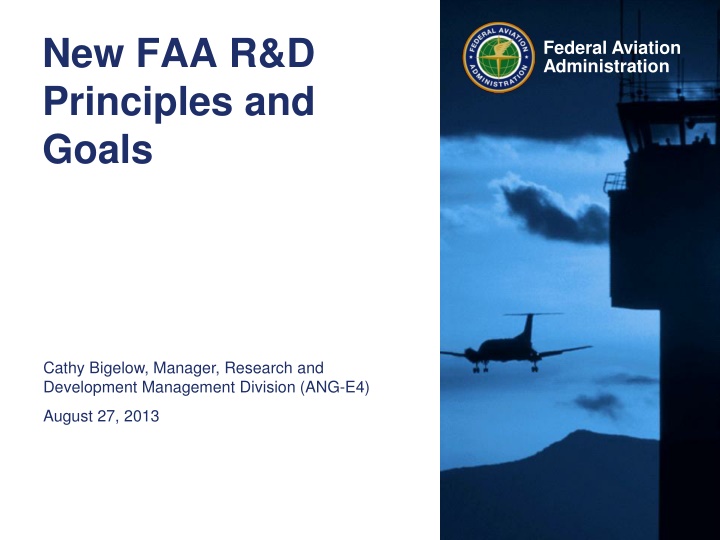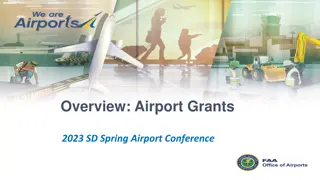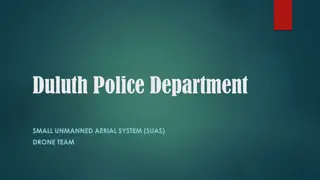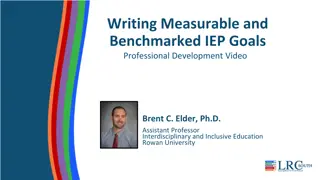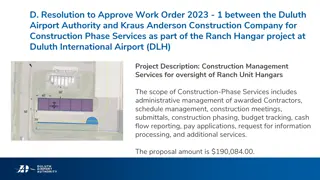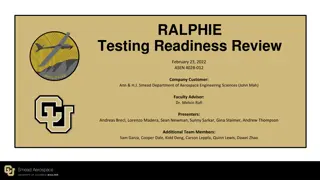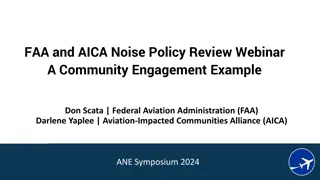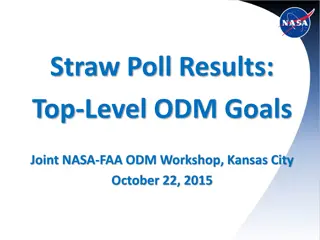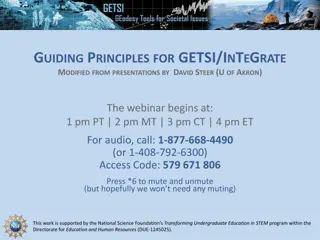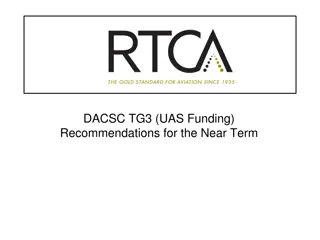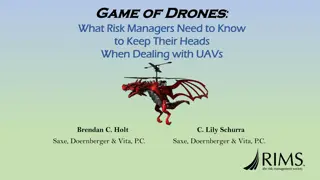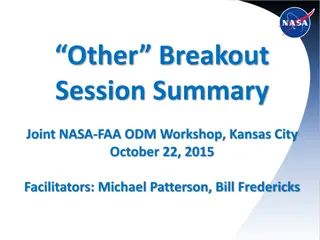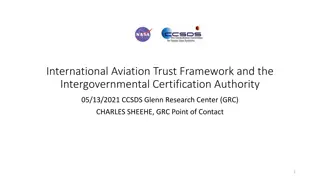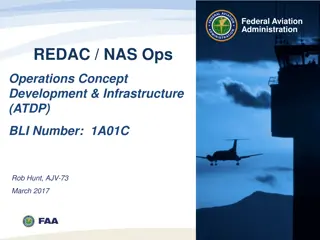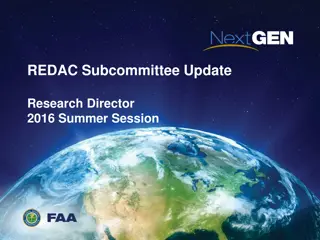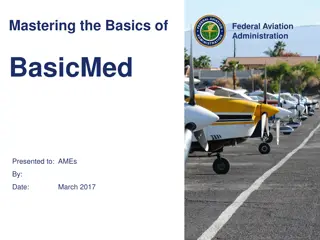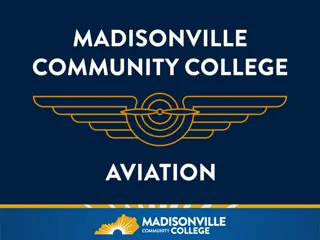New FAA R&D Principles and Goals Overview
In this presentation by Cathy Bigelow, Manager of the FAA's Research and Development Management Division, the background and development process of the new R&D principles for the Federal Aviation Administration are discussed. The evolution of R&D goals from pre-2006 to aligning with Destination 2025 is outlined, along with the decision to create new R&D goals organized by common research areas. The aim is to strengthen alignment with the National Aeronautics Research and Development Plan and integrate NextGen into the FAA's strategic plan.
Download Presentation

Please find below an Image/Link to download the presentation.
The content on the website is provided AS IS for your information and personal use only. It may not be sold, licensed, or shared on other websites without obtaining consent from the author.If you encounter any issues during the download, it is possible that the publisher has removed the file from their server.
You are allowed to download the files provided on this website for personal or commercial use, subject to the condition that they are used lawfully. All files are the property of their respective owners.
The content on the website is provided AS IS for your information and personal use only. It may not be sold, licensed, or shared on other websites without obtaining consent from the author.
E N D
Presentation Transcript
New FAA R&D Principles and Goals Federal Aviation Administration Cathy Bigelow, Manager, Research and Development Management Division (ANG-E4) August 27, 2013
Briefing Overview Background Development Process New R&D Principles Federal Aviation Administration 2
Background Prior to 2006, FAA R&D Goals did not exist in the NARP R&D programs (Budget Line Items) were aligned with the goals, objectives, and performance targets in the FAA Flight Plan Ten crosscutting R&D goals were developed to balance near- and long-term needs and first appeared in the 2006 NARP Near-term: FAA Flight Plan goals Long-term: Goals and capabilities identified by JPDO in the NGATS (NextGen) Integrated Plan Federal Aviation Administration 3
Background 2008 NARP was the first year to align with the mid- term Operational Evolution Partnership (now known as NextGen Implementation Plan) and the JPDO R&D Plan In 2011, Destination 2025 replaced the Flight Plan as the FAA s strategic plan 2012 NARP began aligning existing R&D Goals to Destination 2025 To fully align with Destination 2025, the R&D Goals and NARP format needed to be re-evaluated (changes to debut in the 2013 NARP) Federal Aviation Administration 4
Development Process Six-month process administered by the FAA R&D Management Division and executed through the FAA R&D Executive Board (REB) Four basic alternatives presented to the REB Delete the concept of an R&D Goal altogether and go back to simply tying research efforts (BLIs) directly to components of Destination 2025 Delete the current ten R&D Goals and start over by creating new ones Delete some of the current goals and add some new goals Revise existing R&D Goals REB decided to create new R&D Goals, organized by common research area (less crosscutting ) Federal Aviation Administration 5
Development Process There was a desire to strengthen the alignment between the NARP and the NSTC National Aeronautics Research and Development Plan, as well as integrate the Next Generation Air Transportation System (NextGen) more uniformly throughout the NARP. REB thoroughly analyzed the existing 10 R&D goals, R&D Targets, and Methods of Validation and replaced them with 3 new R&D principles and 22 R&D goals. Improve Aviation Safety (10 R&D goals) Improve Efficiency (7 R&D goals) Reduce Environmental Impacts (5 R&D goals) Federal Aviation Administration 6
Development Process Updated R&D principles were derived from the major RE&D budget line item groupings and consistent with the three standard pillars found in relevant strategic documents Safety Mobility/Flexibility/Efficiency/Access/Capacity Environment and Energy/Sustainability World Leadership is no longer a separate goal and is addressed by each program individually, as applicable Three programs (BLIs) no longer own milestones and their funding is appropriately spread across all three R&D Principles: William J. Hughes Technical Center Laboratory Facility System Planning and Resource Management Center for Advanced Aviation System Development (CAASD) Federal Aviation Administration 7
New R&D Principles Crosswalk National Aeronautics Research and Development Plan Principles DOT Strategic Plan Goals New FAA R&D Principles Destination 2025 Goals Previous FAA R&D Goals 2006-2012 NARP High Quality Teams and Individuals Safe Improve Aviation Safety Aerospace Vehicles Next Level of Safety Safety Aviation Safety Human-Centered Design Situational Awareness Human Protection Delivering Aviation Access Through Innovation Fast, Flexible, and Efficient Improve Efficiency Economic Competiveness System Knowledge Mobility Separation Assurance Reduce Environmental Impacts Clean and Quiet Environmental Sustainability Energy and Environment Sustaining Our Future Improved Global Performance Through Collaboration World Leadership Federal Aviation Administration 8
New R&D Principles Improve Aviation Safety (10 goals) Systematically expand and apply knowledge to produce useful materials, devices, systems, or methods that will improve aviation and space safety and achieve the lowest possible accident rate. Improve Efficiency (7 goals) Systematically expand and apply knowledge to produce useful materials, devices, systems, or methods that will improve access to and increase capacity and efficiency of the nation s aviation system. Reduce Environmental Impacts (5 goals) Systematically expand and apply knowledge to produce useful materials, devices, systems, or methods that will reduce aviation s environmental and energy impacts to a level that does not constrain growth. Federal Aviation Administration 9
Aviation Safety R&D Goal 1 Improved understanding of aerospace vehicle design, structure, and subsystems to reduce the potential for accidents and incidents and support the development of standards and policy and methodologies and tools for certification Advanced Materials/Structural Safety (RE&D - A11.c) Aircraft Catastrophic Failure Prevention Research (RE&D - A11.f) Aircraft Icing/Digital System Safety (RE&D - A11.d) Continued Airworthiness (RE&D - A11.e) NextGen - Advanced Systems and Software Validation (RE&D - A11.n) Propulsion and Fuel Systems (RE&D - A11.b) Unmanned Aircraft Systems Research (RE&D - A11.l) Federal Aviation Administration 10
Aviation Safety R&D Goal 2 Improved knowledge of the human-system interface and a reduction in accidents and incidents through enhanced aerospace vehicle, air traffic, and technical operations that adapt to, compensate for, and augment the performance of the human Air Traffic Control/Technical Operations Human Factors (RE&D - A11.i) Flightdeck/Maintenance/System Integration Human Factors (RE&D - A11.g) NextGen - Air Ground Integration Human Factors (RE&D - A12.c) Federal Aviation Administration 11
Aviation Safety R&D Goal 3 Improved understanding of factors that influence human physiology and performance in aerospace environments and guidance and tools that enhance human safety, protection, and survival during civil aerospace operations Aeromedical Research (RE&D - A11.j) Fire Research and Safety (RE&D - A11.a) Federal Aviation Administration 12
Aviation Safety R&D Goal 4 Improved system-wide access and sharing of aviation safety data and analysis tools within the aviation community, providing safety resources that are integrated with operations of aviation industry stakeholders Safety, Security, Environment Systems Safety Management Transformation (F&E - 1A07G - NextGen Systems Development) System Safety Management (RE&D - A11.h) Federal Aviation Administration 13
Aviation Safety R&D Goals 5 and 6 Established requirements and standards for enabling the availability and improving the quality and quantity of meteorological information to safely implement NextGen operational improvements Improved accuracy and accessibility of observed and forecast weather to reduce the number of accidents and incidents attributed to hazardous weather NextGen - Weather Technology in the Cockpit (RE&D - A12.d) Weather Program (RE&D - A11.k) Federal Aviation Administration 14
Aviation Safety R&D Goals 7, 8, and 9 Optimized technical and regulatory provisions and processes used to oversee, coordinate, regulate, and promote safe and responsible activities for reliable aerospace operations between space and Earth Improved vehicle safety and risk management, including knowledge of all safety-critical components and systems of the space vehicles and their operations, to better identify potential hazards and apply and verify hazard controls Guidance and tools that enhance human safety, protection, and survival during space operations Commercial Space Transportation Safety (Ops) Federal Aviation Administration 15
Aviation Safety R&D Goal 10 No fatal accidents on certificated airports as a result of airport design, runway incursions or excursions, or wildlife strikes Airport Cooperative Research Program Safety (AIP) Airport Technology Research Program Safety (AIP) Runway Incursion Reduction Program (F&E - 1A01A Advanced Technology Development and Prototyping) Federal Aviation Administration 16
Aviation Safety R&D Goals Alignment with NSTC Goals FAA R&D Principle NSTC Principle NSTC Goals FAA R&D Goals FAA R&D Programs Advanced Materials/Structural Safety Goal 1 - Develop Technologies to Reduce Accidents and Incidents Through Enhanced Vehicle Design, Structure, and Subsystems Aircraft Catastrophic Failure Prevention Research Propulsion and Fuel Systems 1 - Improved understanding of aerospace vehicle design, structure, and subsystems to reduce the potential for accidents and incidents and support the development of standards and policy and methodologies and tools for certification. Aviation Safety is Paramount Improve Aviation Safety Goal 2 - Develop Technologies, for Manned and Unmanned Systems, to Reduce Accidents and Incidents through Enhanced Aerospace Vehicle Operations on the Ground and in the Air Continued Airworthiness Aircraft Icing/Digital Systems Safety NextGen Advanced Systems and Software Validation Unmanned Aircraft Systems Research Program Air Traffic Control/Technical Operations Human Factors Flightdeck/Maintenance/System Integration Human Factors NextGen - Air Ground Integration Human Factors 2 - Improved knowledge of the human-system interface and a reduction in accidents and incidents through enhanced aerospace vehicle, air traffic, and technical operations that adapt to, compensate for, and augment the performance of the human. Goal 2 - Develop Technologies, for Manned and Unmanned Systems, to Reduce Accidents and Incidents through Enhanced Aerospace Vehicle Operations on the Ground and in the Air Federal Aviation Administration 17
Aviation Safety R&D Goals Alignment with NSTC Goals FAA R&D Principle NSTC Principle NSTC Goals FAA R&D Goals FAA R&D Programs 3 - Improved understanding of factors that influence human physiology and performance in aerospace environments and guidance and tools that enhance human safety, protection, and survival during civil aerospace operations. Aeromedical Research Goal 3 - Demonstrate Enhanced Passenger and Crew Survivability in the Event of an Accident Fire Research and Safety Aviation Safety is Paramount Improve Aviation Safety 4 - Improved system-wide access and sharing of aviation safety data and analysis tools within the aviation community, providing safety resources that are integrated with operations of aviation industry stakeholders. System Safety Management Goal 2 - Develop Technologies, for Manned and Unmanned Systems, to Reduce Accidents and Incidents through Enhanced Aerospace Vehicle Operations on the Ground and in the Air Safety, Security, Environment Systems Safety Management Transformation 5 - Established requirements and standards for enabling the availability and improving the quality and quantity of meteorological information to safely implement NextGen operational improvements. 6 - Improved accuracy and accessibility of observed and forecast weather to reduce the number of accidents and incidents attributed to hazardous weather. NextGen - Weather Technology in the Cockpit Goal 2 - Develop Technologies, for Manned and Unmanned Systems, to Reduce Accidents and Incidents through Enhanced Aerospace Vehicle Operations on the Ground and in the Air Weather Program Federal Aviation Administration 18
Aviation Safety R&D Goals Alignment with NSTC Goals FAA R&D Principle NSTC Principle NSTC Goals FAA R&D Goals FAA R&D Programs 7 - Optimized technical and regulatory provisions and processes used to oversee, coordinate, regulate, and promote safe and responsible activities for reliable aerospace operations between space and Earth. Aviation Safety is Paramount Goal 2 - Develop Technologies, for Manned and Unmanned Systems, to Reduce Accidents and Incidents through Enhanced Aerospace Vehicle Operations on the Ground and in the Air Improve Aviation Safety 8 - Improved vehicle safety and risk management, including knowledge of all safety- critical components and systems of the space vehicles and their operations, to better identify potential hazards and apply and verify hazard controls. Commercial Space Transportation Safety 9 - Guidance and tools that enhance human safety, protection, and survival during space operations. Runway Incursion Reduction Program Airport Cooperative Research Program - Safety Airport Technology Research Program - Safety Goal 2 - Develop Technologies, for Manned and Unmanned Systems, to Reduce Accidents and Incidents through Enhanced Aerospace Vehicle Operations on the Ground and in the Air 10 - No fatal accidents on certificated airports as a result of airport design, runway incursions or excursions, or wildlife strikes. Federal Aviation Administration 19
New R&D Principles Improve Aviation Safety (10 goals) Systematically expand and apply knowledge to produce useful materials, devices, systems, or methods that will improve aviation and space safety and achieve the lowest possible accident rate. Improve Efficiency (7 goals) Systematically expand and apply knowledge to produce useful materials, devices, systems, or methods that will improve access to and increase capacity and efficiency of the nation s aviation system. Reduce Environmental Impacts (5 goals) Systematically expand and apply knowledge to produce useful materials, devices, systems, or methods that will reduce aviation s environmental and energy impacts to a level that does not constrain growth. Federal Aviation Administration 20
Efficiency R&D Goal 1 Necessary NextGen related research priorities are identified, defined, and coordinated with partner agencies for improvements in efficiency and capacity Joint Planning and Development Office (RE&D - A12.a) Federal Aviation Administration 21
Efficiency R&D Goal 2 Improved aircraft separation processes associated with current generalized and static air navigation service provider wake turbulence mitigation separation standards NextGen - Wake Turbulence (RE&D - A12.b) Wake Turbulence - Re-Categorization (F&E - 1A07E NextGen Systems Development) Federal Aviation Administration 22
Efficiency R&D Goal 3 Improved human-system integration and an increase in ATC efficiency through enhanced controllers-pilots coordination in cooperatively managing traffic loads as cockpit technology and air traffic workstations are more closely connected NextGen - Air Ground Integration Human Factors (RE&D - A12.c) Air Traffic Control/Technical Operations Human Factors (Controller Efficiency and Air Ground Integration) (F&E - 1A07A NextGen Systems Development) Federal Aviation Administration 23
Efficiency R&D Goal 4 Feasible procedures, operational methods, and technologically-advanced systems that can decrease workload and increase efficiency of the NAS Major Airspace Redesign (F&E - 1A01D - Advanced Technology Development and Prototyping) New Air Traffic Management Requirements (F&E - 1A07B NextGen Systems Development) Operations Concept Validation Modeling (F&E - 1A07C NextGen Systems Development) Networked Facilities - Staffed NextGen Towers (F&E - 1A07H NextGen Systems Development) Operations Concept Validation and Infrastructure Evolution (F&E - 1A01C - Advanced Technology Development and Prototyping) System Capacity, Planning and Improvements (F&E - 1A01B - Advanced Technology Development and Prototyping) Federal Aviation Administration 24
Efficiency R&D Goals 5 and 6 Established requirements and standards for enabling availability and improving the quality and quantity of meteorological information to reduce impacts of adverse weather on rerouting, NAS capacity, and NextGen operational procedures Improved accuracy and accessibility of observed and forecast weather information to improve NAS efficiency (e.g., reduced delays and cancellations, increased capacity in high traffic areas) NextGen - Weather Technology in the Cockpit (RE&D - A12.d) Weather Program (RE&D - A11.k) Federal Aviation Administration 25
Efficiency R&D Goal 7 Availability of existing airport facilities protected and used as efficiently as possible, while making strategic investments in new facilities consistent with evolving aviation needs Airport Cooperative Research Program Capacity (AIP) Airport Technology Research Program Capacity (AIP) Federal Aviation Administration 26
Efficiency R&D Goals Alignment with NSTC Goals FAA R&D Principle NSTC Principle NSTC Goals FAA R&D Goals FAA R&D Programs 1 - Necessary NextGen related research priorities are identified, defined, and coordinated with partner agencies for improvements in efficiency and capacity. Goal 5 - Develop Expanded Manned and Unmanned Aircraft System Capabilities to Take Advantage of Increased Air Transportation System Performance Joint Planning and Development Office Mobility Through the Air is Vital to Economic Stability, Growth, and Improve Efficiency Security as a Nation Goal 1 - Develop Reduced Aircraft Separation in Trajectory- and Performance-Based Operations 2 - Improved aircraft separation processes associated with current generalized and static air navigation service provider wake turbulence mitigation separation standards. NextGen - Wake Turbulence Goal 4 - Maximize Arrivals and Departures at Airports and in Metroplex Areas Wake Turbulence - Re-categorization NextGen - Air Ground Integration Human Factors Air Traffic Control/Technical Operations Human Factors (Controller Efficiency and Air Ground Integration) 3 - Improved human-system integration and an increase in ATC efficiency through enhanced controllers-pilots coordination in cooperatively managing traffic loads as cockpit technology and air traffic workstations are more closely connected. Goal 1 - Develop Reduced Aircraft Separation in Trajectory- and Performance-Based Operations Goal 4 - Maximize Arrivals and Departures at Airports and in Metroplex Areas Federal Aviation Administration 27
Efficiency R&D Goals Alignment with NSTC Goals FAA R&D Principle NSTC Principle NSTC Goals FAA R&D Goals FAA R&D Programs Goal 1 - Develop Reduced Aircraft Separation in Trajectory- and Performance-Based Operations Economic Stability, Growth, and Security New Air Traffic Management Requirements Mobility Through the Air is Vital to Goal 2 - Develop Increased NAS Capacity by Managing NAS Resources and Air Traffic Flow Contingencies Improve Efficiency Goal 4 - Maximize Arrivals and Departures at Airports and in Metroplex Areas as a Nation 4 - Feasible procedures, operational methods, and technologically-advanced systems that can decrease workload and increase efficiency of the NAS. Major Airspace Redesign System Capacity, Planning and Improvements Operations Concept Validation Modeling Networked Facilities - Staffed NextGen Towers Operations Concept Validation and Infrastructure Evolution Federal Aviation Administration 28
Efficiency R&D Goals Alignment with NSTC Goals FAA R&D Principle NSTC Principle NSTC Goals FAA R&D Goals FAA R&D Programs 5 - Established requirements and standards for enabling availability and improving the quality and quantity of meteorological information to reduce impacts of adverse weather on rerouting, NAS capacity, and NextGen operational procedures. 6 - Improved accuracy and accessibility of observed and forecast weather information to improve NAS efficiency (e.g., reduced delays and cancellations, increased capacity in high traffic areas). 7 - Availability of existing airport facilities protected and used as efficiently as possible, while making strategic investments in new facilities consistent with evolving aviation needs. Goal 2 - Develop Increased NAS Capacity by Managing NAS Resources and Air Traffic Flow Contingencies Economic Stability, Growth, and Security Mobility Through the Air is Vital to NextGen - Weather Technology in the Cockpit Goal 3 - Reduce the Adverse Impacts of Weather on Air Traffic Management Decisions Improve Efficiency as a Nation Weather Program Airport Cooperative Research Program - Capacity Goal 2 - Develop Increased NAS Capacity by Managing NAS Resources and Air Traffic Flow Contingencies Airport Technology Research Program - Capacity Federal Aviation Administration 29
New R&D Principles Improve Aviation Safety (10 goals) Systematically expand and apply knowledge to produce useful materials, devices, systems, or methods that will improve aviation and space safety and achieve the lowest possible accident rate. Improve Efficiency (7 goals) Systematically expand and apply knowledge to produce useful materials, devices, systems, or methods that will improve access to and increase capacity and efficiency of the nation s aviation system. Reduce Environmental Impacts (5 goals) Systematically expand and apply knowledge to produce useful materials, devices, systems, or methods that will reduce aviation s environmental and energy impacts to a level that does not constrain growth. Federal Aviation Administration 30
Environment and Energy R&D Goals 1, 2, and 3 Reduced significant community noise impacts in absolute terms Reduced impact of aviation emissions on air quality and global climate Improved energy efficiency and assured availability of sustainable alternative jet fuels Environment and Energy (RE&D - A13.a) Environment and Energy Environmental Management Systems and Advanced Noise and Emissions Reduction (F&E - 1A07D NextGen Systems Development) NextGen - Environmental Research - Aircraft Technologies, Fuels, and Metrics (RE&D - A13.b) Safety, Security, Environment Operational Assessments (F&E - 1A07F NextGen Systems Development) NextGen - Weather Technology in the Cockpit (RE&D - A12.d) Federal Aviation Administration 31
Environment and Energy R&D Goal 4 Established requirements, policies, procedures, and resources to allow airports in the United States to become environmentally-friendly neighbors Airport Cooperative Research Program Environment (AIP) Airport Technology Research Program Environment (AIP) Federal Aviation Administration 32
Environment and Energy R&D Goal 5 Established data and methodologies to support certification of alternative fuels for General Aviation aircraft NextGen - Alternative Fuels for General Aviation (RE&D - A11.m) Federal Aviation Administration 33
Environment and Energy R&D Goals Alignment with NSTC Goals FAA R&D Principle NSTC Principle NSTC Goals FAA R&D Goals FAA R&D Programs Assuring Energy Availability and Efficiency is Central to Goal 1 - Enable New Aviation Fuels Derived from Diverse and Domestic Resources to Improve Fuel Supply Security and Price Stability and the Environment Must be Protected while Environment and Energy the Growth of the Aeronautics Enterprise, Sustaining Growth in Air Transportation Goal 3 - Advance Development of Technologies and Operational Procedures to Decrease the Significant Environmental Impacts of the Aviation System Reduce Environmental Impact Goal 2 - Advance Development of Technologies and Operations to Enable Significant Increases in the Energy Efficiency of the Aviation System NextGen - Environmental Research - Aircraft Technologies, Fuels, and Metrics 1 - Reduced significant community noise impacts in absolute terms. 2 - Reduced impact of aviation emissions on air quality and global climate. Environment and Energy Environmental Management Systems and Advanced Noise and Emissions Reduction 3 - Improved energy efficiency and assured availability of sustainable alternative jet fuels. Safety, Security, Environment Operational Assessments NextGen - Weather Technology in the Cockpit Federal Aviation Administration 34
Environment and Energy R&D Goals Alignment with NSTC Goals FAA R&D Principle NSTC Principle NSTC Goals FAA R&D Goals FAA R&D Programs Central to the Growth of the Aeronautics Enterprise, Goal 1 - Enable New Aviation Fuels Derived from Diverse and Domestic Resources to Improve Fuel Supply Security and Price Stability and the Environment Must be Protected while Assuring Energy Availability and Efficiency is Goal 3 - Advance Development of Technologies and Operational Procedures to Decrease the Significant Environmental Impacts of the Aviation System Sustaining Growth in Air Transportation Reduce Environmental Impact Airport Cooperative Research Program - Environment 4 - Established requirements, policies, procedures, and resources to allow airports in the United States to become environmentally- friendly neighbors. Goal 2 - Advance Development of Technologies and Operations to Enable Significant Increases in the Energy Efficiency of the Aviation System Airport Technology Research Program - Environment Goal 3 - Advance Development of Technologies and Operational Procedures to Decrease the Significant Environmental Impacts of the Aviation System 5 - Established data and methodologies to support certification of alternative fuels for General Aviation aircraft. NextGen - Alternative Fuels for General Aviation Federal Aviation Administration 35
Summary The FAA developed new R&D Goals using a systematic, six-month process executed through the REB and managed by the R&D Management Division. The previous 10 R&D Goals, R&D Targets, and Methods of Validation were replaced with 3 new R&D principles and 22 R&D goals. The new R&D principles and goals map directly to the three central pillars common to strategic goals at the FAA, DOT, and Office of Science and Technology Policy (OSTP). Federal Aviation Administration 36
